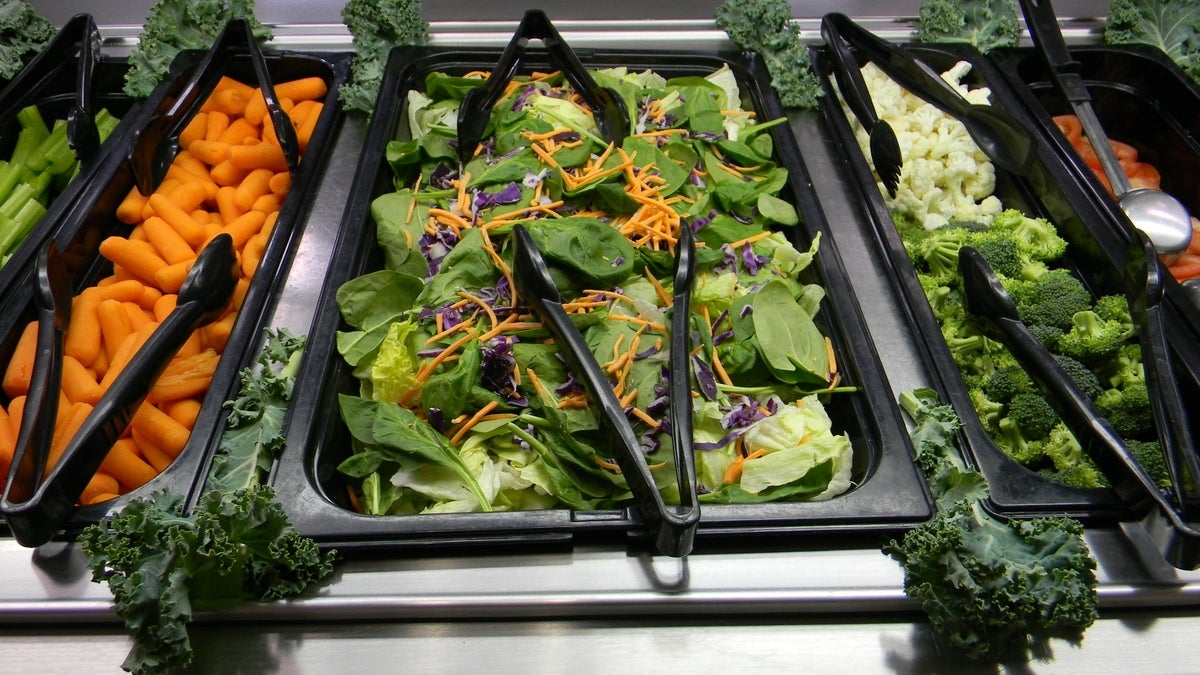Update: The Wall Street Journal included ASU research in its Feb. 24, 2017, article, “How Schools Can Get Children to Eat Their Vegetables.”
What’s the best way to get school kids to eat their fruits and veggies? Well, a team of ASU health researchers discovered it’s all about where you place the salad bar.
“Past studies looked at whether students attending schools with salads ate more fruits and vegetables at lunch compared to schools without them,” said Marc A. Adams, an assistant professor at ASU’s School of Nutrition and Health PromotionThe School of Nutrition and Health Promotion is in the College of Health Solutions.. “Our study examined a different question: Once salad bars are implemented at schools, what is the best location for them in the cafeteria?”
The main find revealed that students consumed almost five times the amount of fruits and vegetables when salad bars were placed inside the cafeteria line prior to point of purchase compared with salad bars displayed outside the serving line. Adams believes a number of factors come into play with that finding, but mostly it’s a case of out of sight, out of mind.
“We were surprised, not that there was a difference in amounts of fruits and vegetables consumed, but by the size of the difference that placement had on students’ choices,” Adams said.
The study, called “Location of School Lunch Salad Bars and Fruit and Vegetable Consumption in Middle Schools: A Cross-Sectional Plate Waste Study,” was a cross-sectional comparative study conducted across two school districts, both in the greater Phoenix region, and included six middle schools. It examined consumption among 533 students randomly sampled on a single day from each school and looked at fruit and vegetable consumption and waste by the placement of the salad bar. The study was funded by a $50,000 grant by the Virginia G. Piper Charitable Trust, which allowed Adams, along with Meg Bruening, Punam Ohri-Vachspati and Jane C. Hurley, to look at the behavioral economics behind students' food take, consumption and plate-waste methodology.
Another paper, written by ASU investigators Ohri-Vachaspati, Adams and Bruening, in collaboration with Bridging the Gap researchers at the University of Illinois at Chicago, "School Resources and Engagement in Technical Assistance Programs Is Associated with Higher Prevalence of Salad Bars in Elementary School Lunches in the United States," examined school-level resources and programs that are related to salad bar implementation in a national sample of close to 4,000 elementary schools. This work, funded by the Robert Wood Johnson Foundation, found that the prevalence of salad bars in elementary schools has increased more than 50 percent over the course of five years and that schools were more likely to have salad bars if they also had other nutrition programming such as a farm to school program or participated in fresh fruit and vegetable snack program.
Both papers will be published in the March issue of the Journal of the Academy of Nutrition and Dietetics, a flagship journal of the Academy of Nutrition and Dietetics.
But the big takeaway is that the placement of the salad bar is so crucial to consumption of fruits and vegetables.
“Behavioral economics suggest that children’s choices are not rational and that simple modifications to school cafeterias can have meaningful impact on improving students’ dietary modifications,” Adams said. “Once students exit the serving line, most will not seek out additional opportunities to take fruits and vegetables because it might mean breaking away from friends or navigating busy cafeterias with short lunch periods. Placement is one of those simple modifications that can help nudge students to make the best choices to improve their fruit and vegetable intake without asking them or telling them to do so.”
But in some cases, it’s easier said than done. Enforcement of where a salad bar goes is not so easy to do, and for older schools in dense urban areas this placement may not always be possible because of limitations on space.
“We are not necessarily suggesting that schools reconfigure or realign their cafeterias, but one thing we would say is that if new schools are being built or if kitchens are being redesigned, they may want to consider putting those salad bars in those lines,” said Bruening, an assistant professor in the School of Health and Nutrition. “Placement of salad bars matter, and if there’s a way to promote them, then they should.”
More Health and medicine
ASU team part of nationwide study looking at Type 2 diabetes in youth
Near the end of an interview in which he talked about the work his team will be doing to tackle the rise in Type 2 diabetes among youth, Arizona State University Professor Gabe Shaibi answered why…
Leading the way in wellness: ASU highlighted in The Princeton Review's 2025 Mental Health Services Honor Roll
Being a college student isn’t easy — navigating new routines, people and places can be a challenge, especially if the right support system is not in place. That's why Arizona State University is a…
New Indigenous health dashboard offers robust database for scholars
By Nicole Greason and Kimberly Linn A team at Arizona State University’s College of Health Solutions and American Indian Studies program has created a new tool to aid researchers…
